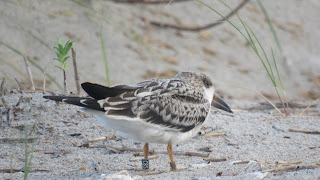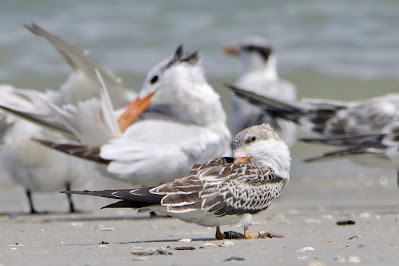Wednesday, September 28, 2022
Saturday, September 10, 2022
A Peaceful Ending for the 2022 Nesting Season
.JPEG) |
| photo by Kris Lee |
We know that many of our birds stay in the Wrightsville Beach area until November. Each year it appears that they “stage” i.e., wait for others to make it down the Atlantic coast to our area and then leave together in large flocks. The photo above was taken on September 2nd at the north end of Wrightsville Beach and shows hundreds of Black Skimmers gathered by the inlet.
The posting was removed by a group of Wrightsville Beach Stewards on September 6. Almost all of our chicks had successfully learned to fly and had left the colony. They will continue to practice their new skills as they get ready to head south.
Throughout the summer we were able to band 110 Black Skimmer chicks. Some of our Black Skimmers have already begun the trip South. We recently received a text from a SC Bird Steward, Alice Belanger. Our steward, Jin Bian, met Alice this summer when she was visiting our nesting colony and photographing our birds.
Alice sent photos (see below) taken on Sunday, 8/28 in Huntington Beach, SC of Black Skimmer fledglings that were banded. She wanted to know if they might be our Black Skimmer fledglings, C23 and C45…AND THEY ARE!!!! The fledglings were photographed with adult Black Skimmers (parents!!) and several Royal Terns. The news made us so happy and reinforced how much information we can receive from the process and effort of banding birds.
So with treasured memories of our successful colonies of Black Skimmers, Least Terns, and Common Terns this summer we are already eagerly waiting to do it all again in 2023!
Tuesday, August 23, 2022
We Still Have Stories To Share From the South End of Wrightsville Beach
We are approaching the end of the nesting season and the bird posting has been pretty quiet. But.....
BLACK SKIMMERS
We still have young Skimmers hiding in the heavy vegetation and groups of Black Skimmers continue to roost in the posting. The bird posting may be quiet, but important bird activity is happening in the area of the south end, Masonboro Inlet, Masonboro Island, the north end of Wrightsville and the local tidal creeks!!
We have a small group of Black Skimmers caring for chicks in the oceanfront area of the posting close to the point. These photographs and videos were taken in the last two weeks and each has it's own story to share.
 |
| This young skimmer chick was born at the very end of July. |
 |
| another young skimmer |
 |
| The adult Skimmers react when a large gull tries to take a fish from a fledgling. |
 |
| Parent skimmers are still feeding fledglings who are just learning to fly. |
 |
| Look for banded fledglings! |
 |
| Groups of skimmers on the oceanfront area of the colony close to the point. |
Videos are a great way to not only watch but a chance to listen to the activity!
LEAST TERNS & COMMON TERNS
All of the Least Terns AND Common Terns have left the posting, but training of fledglings in fishing and strong flying skills is happening as they prepare for migration. Feeding of fledglings by the parent birds will continue through migration as they improve their own fishing skills.
Least Terns and Common Terns continue to fly over the south end with fledglings and fishing continues in the inlet and along the Wrightsville Beach coast line.
OYSTERCATCHERS AND OTHER GUESTS
The Oystercatcher pair returns to the south end generally two hours before and after the High Tide time… and around mid-tide.
Royal and Sandwich Terns, as well as other migrating species, can also be found in the area.
Going back to see some of our earlier posts will give us a chance to check out what happened with nesting this summer!
Thursday, August 4, 2022
Going, Going, Going … But Not Yet Gone!
.jpg) |
| photo by Evan Mauk |
 |
| photo by Evan Mauk |
 |
| photo by Evan Mauk |
 |
| photo by Evan Mauk |
Notice the bands on the Black Skimmers in the next two photographs.
 |
| photo by Evan Mauk |
Friday, July 22, 2022
As the Summer Heats Up the Colony Continues To Grow
 |
| photo by Kathy Hannah |
We are so excited to share fantastic news of the banding of 65 Black Skimmer chicks this month! We have banded a total of 83 Black Skimmer chicks this nesting season on the South End. Lindsay Addison, Audubon NC’s Coastal Biologist, invited an experienced group from UNCW, Airlie Gardens and her Coastal Team to capture and band chicks.
 |
| photo by Martin West |
 |
| photo by Martin West |
The chicks we band are approximately 3 weeks old…old enough that they are growing their feathers and not downy, can tolerate being held by a human and not flying yet. We were so happy to have so many skilled helpers to weigh and measure each chick’s total head measurement including its bill and wing chord. Only experienced individuals may go into the colony with Lindsay (Audubon NC’s Coastal Biologist) to find the chicks as they hide very well in all the vegetation. It was especially important because more nests (with eggs) and newly hatching chicks were seen in the colony.
Biologists learn so much from banding and re-sighting of the Black Skimmers. For example, we have confirmed this year that the chicks that hatch on the south end of Wrightsville Beach return to the south end of Wrightsville Beach as adults and nest! Bands give us PROOF!
Black Skimmers Show That Protecting One Beach Is Not Enough
.jpg) |
| Photo: Anna Parot |
Black Skimmer and Common Tern chicks have been hatching throughout the colony this past week and chicks are running around. We have a nice variety of chicks including older chicks that have developed their flight feathers and are beginning to fly. It is very entertaining to watch Black Skimmer parents “coaching” (encouraging) their chicks to fly using a fish for incentive! Watch the shoreline for both parents flying with their chick who is just taking off.
 |
| photo by Martin West |
 |
| photo by Martin West |
Parent Black Skimmers are also escorting their chicks to the water and the reaction of the chicks to that first feeling of water is priceless…. get your binoculars out and watch them up close.
 |
| photo by Kathy Hannah |
Watch for parent birds returning to the colony with fish and they will lead you right to their sweet chicks. Feeding chicks is energy intensive for the parent birds.
 |
| photo by Tom Hanna |
 |
| photo by Tom Hanna |
 |
| photo by Tom Hanna |
 |
| photo by Tom Hanna |
 |
| photo by Tom Hanna |
Common Terns have a unique behavior to spread out their chicks when feeding by making the chicks chase the parent coming in with fish so the biggest chick is not always the one to get the fish. I am so impressed with the Common Tern…they seem to know how to raise 2-3 chicks to fledge!
 |
| photo by Kathy Hannah |
A few Black Skimmer and Common Tern chicks hatched this past week on the inlet side of the posting. Thank you to all of our beach guests who help reduce disturbance in the colony. This continues to be important because of the added heat stress during these hot summer days.
There is a nice variety of chicks in the colony right now. Older chicks have developed their flight feathers and are beginning to fly and learning to skim.
Skimmer Chicks
(photos by Kathy Hannah)
 |
| photo by Kathy Hannah |
Common Tern Chick
 |
| photo by Kathy Hannah |
Looking forward to seeing you at the beach!

























